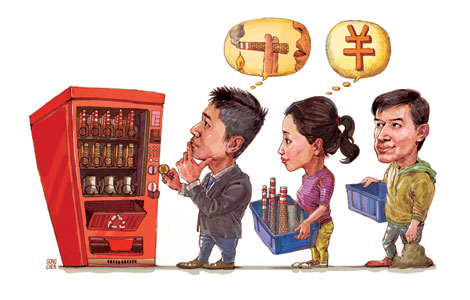Getting it right on site as competition increases
Updated: 2013-07-29 07:19
By Cecily Liu in London (China Daily)
|
||||||||
"These items are relatively basic, but their consumption increases in urban areas where people can find these goods more easily and at better prices. They start to buy them more regularly."
As people's income grows, they can afford extra consumer items on top of the basic ones, and sectors such as luxury goods, travel services, communications, cars, skincare products and restaurants would see even faster growth, he says.
Also, urbanization increases the speed of communication and interaction. This encourages consumption through a network effect because people's buying decisions influence those of friends.
As the Chinese become increasingly sophisticated in demanding better products, they prefer to buy more premium or innovative products.
In China's toothpaste market, Atsmon notes, US manufacturer Procter & Gamble developed Crest more than 10 years ago as a quality line for the Chinese.
It offered a green tea-flavored version and kept prices low through basic packaging and other means, he says. But over time, as the Chinese became wealthier, they looked for more, so brands such as Colgate have grown market share with more premium versions.
Atsmon says that although foreign brands are increasingly eyeing opportunities in the Chinese market, they are facing increasing competition from local competitors.
"I think 10 to 15 years ago there was a big difference between foreign and local brands on, for example, expertise on how to open fast-food restaurant chains.
"Now, some foreign players may still have a scale advantage, but the knowledge is also available to Chinese players."
PepsiCo and Coca-Cola Co used to have the advantage of management expertise, but China's beverage companies, such as giant Hangzhou Wahaha Group Co Ltd, are catching up.
In other sectors, Atsmon adds, Chinese consumer brands, such as the household appliances company Haier Group and technology firm Lenovo Group Ltd, are leading their markets in China. Some are even leading sales globally.
He says these brands have the advantage of extensive distribution networks and the ability to take full advantage of urbanization, even in the smaller Chinese cities.
"Sometimes it's harder for foreign brands that are less flexible in the cost model to come in," he says. "But new opportunities still exist for everyone."
Atsmon believes that as China's urban centers mature, it will be more difficult for new foreign consumer brands to enter, because they would face tough competition from both foreign and Chinese brands that entered the market early.
Most Viewed
Editor's Picks

|

|

|

|

|

|
Today's Top News
Families of crash victims to sue Asiana in the US
Major SOEs eye profits from abroad
Train collision kills at least 44 in Switzerland
Sino-Japanese summit ruled out
Manila's base plan targets China
Hun Sen's party win to stabilize situation: expert
Beijing plans $81b shantytown renovation project
CMOC buys stake in Rio Tinto
US Weekly

|

|















